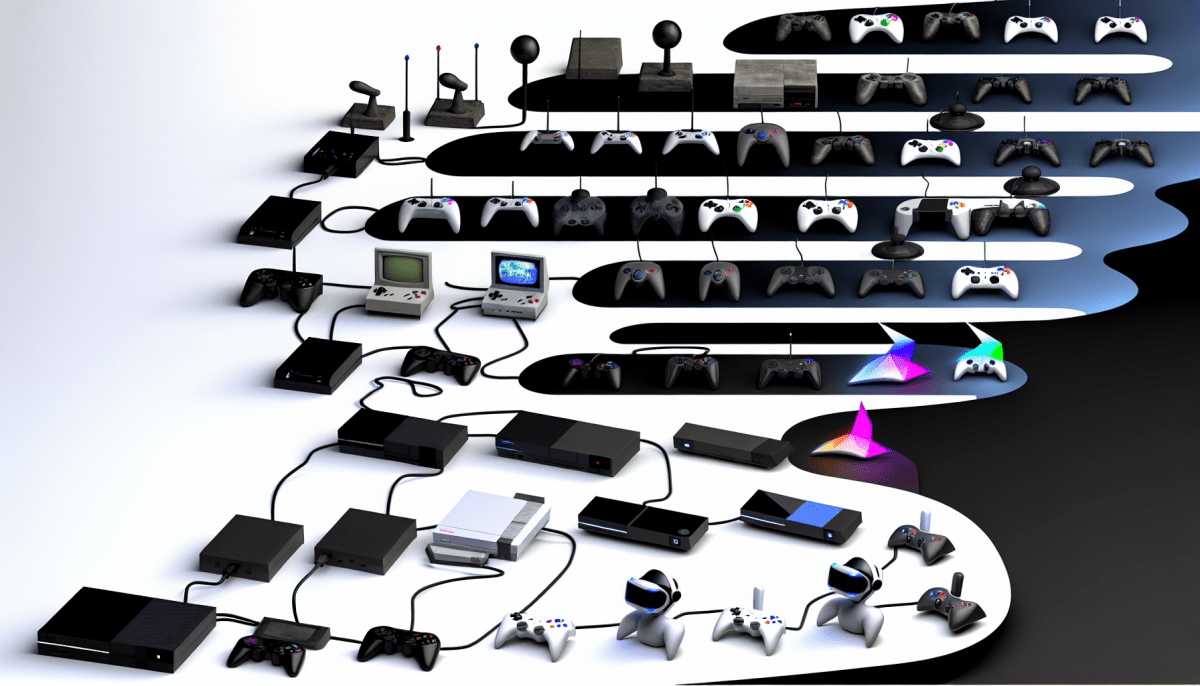From their simple origins, gaming consoles have grown into powerful machines that have changed how we play video games. They've made games look and feel more real, and have made it easier for us to play with others, even in virtual worlds. Let me take you through this transformation.
Controllers got more comfortable and responsive; console designs became sleeker and more user-friendly. When graphics started to look almost like real life, it was a game-changer. We've also got to enjoy a huge variety of games and the exciting move into virtual reality gaming.
These advancements have made gaming consoles much more impressive and important in the industry.
Key Takeaways
- Early consoles like the Magnavox Odyssey and Atari 2600 played a crucial role in shaping the video game industry by establishing business models, consumer expectations, and technology standards.
- Advancements in game controllers have had a profound impact on video gaming, ensuring a seamless connection between players and games through improved ergonomics and precise control.
- Innovation in console design, including miniaturization and customization options, has enhanced the gaming experience and allowed for personalized and space-conscious designs without compromising on power or functionality.
- Breakthroughs in game graphics have dramatically transformed players' visual experiences, from blocky 8-bit textures to hyper-realistic environments, expanding the canvas for game developers to tell their stories and enhancing visual fidelity and gameplay possibilities.
The Early Consoles
Exploring the dawn of the video game era, we've witnessed how the early consoles laid the groundwork for a burgeoning industry. These console pioneers, like the Magnavox Odyssey and Atari 2600, weren't simply electronic novelties but the keystones of market formation in digital entertainment.
Their rudimentary graphics and limited processing capabilities belie their monumental role in defining the interactive experience that consumers now crave. As we analyze their impact, it's clear that they established critical business models, consumer expectations, and technology standards that have shaped the industry's trajectory.
These initial platforms catalyzed a cultural shift, setting the stage for the sophisticated ecosystems we're developing today. Their legacy is a testament to innovation's progressive march, reminding us that today's cutting-edge is tomorrow's foundation.
Advancements in Game Controllers
We've witnessed innovation in the realm of interactivity as advancements in game controllers have profoundly influenced the mechanics and accessibility of video gaming. The focus on controller ergonomics has led to designs that accommodate lengthy gaming sessions without discomfort, ensuring a seamless connection between player and game.
Button sensitivity adjustments have also been crucial; they allow for precise control, catering to both the casual player and the competitive gamer who demands responsiveness.
These enhancements aren't merely incremental; they represent a paradigm shift in how we interact with virtual environments. As controllers continue to evolve, they embody the innovative spirit of the industry, pushing the boundaries of what's possible in gameplay mechanics and immersive experiences.
The journey of controller evolution is, in many ways, the story of gaming itself.
Innovations in Console Design
As we delve into the realm of console design, it's clear that innovation has been pivotal in shaping the gaming experience and industry at large. Console miniaturization exemplifies technological advancement; sleek, compact consoles now fit seamlessly into modern living spaces, enhancing their appeal. This downsizing hasn't sacrificed performance; rather, it has streamlined gaming into more efficient, powerful machines.
Moreover, customization options have become a cornerstone of consumer engagement. Gamers can now modify their consoles with interchangeable faceplates, LED lighting, and even performance-enhancing elements. These features not only personalize the gaming experience but also reflect individuality and style preferences.
As these trends continue, we can anticipate further integration of personalized, space-conscious design that doesn't compromise on power or functionality.
Breakthroughs in Game Graphics
Our journey through console evolution brings us to the realm of game graphics, where advancements have dramatically transformed players' visual experiences. Graphic engines have evolved, enabling the rendering of hyper-realistic environments and dynamic lighting that push the boundaries of immersion. Pixel evolution has taken us from the blocky, 8-bit textures of the past to the near-photorealistic landscapes of today.
Here's a table illustrating key breakthroughs:
| Generation | Graphics Milestone |
|---|---|
| 1st | Basic 2D sprites and backgrounds |
| 2nd | Introduction of 8-bit color depth |
| 3rd | 16-bit graphics, increased resolution |
| 4th | 3D graphics and texture mapping |
| 5th and beyond | Real-time rendering, 4K resolution |
These leaps in technology have not only enhanced visual fidelity but also expanded the canvas upon which game developers can craft their stories.
Rise of Multiplayer Gaming
Building on these graphical milestones, we're now witnessing how multiplayer gaming is reshaping social interaction within the industry. The proliferation of robust online communities has been pivotal.
It's not just about the games anymore; it's about the connections and experiences shared among players. Social gaming has become an integral part of the culture, transcending traditional boundaries and creating spaces where people from diverse backgrounds come together, interact, and collaborate.
Online platforms have revolutionized how we engage with games, turning solitary experiences into communal events. As consoles continue to advance, they facilitate more immersive and interactive environments, further solidifying the role of social gaming.
We're seeing a continuous evolution, where the social aspects of gaming are as important as the technology driving it.
Expanding Game Libraries
We've witnessed how growing game libraries on consoles have transformed the scope and accessibility of video gaming for players worldwide. Digital distribution platforms have reshaped the landscape, allowing for a vast array of genres and titles. Indie developers, once sidelined by the cost of physical production, now thrive in this environment, contributing innovative games to ever-expanding libraries.
Here's a snapshot of this evolution:
| Generation | Impact on Libraries | Key Advancement |
|---|---|---|
| 8th | Indie Boom | Digital Markets |
| 9th | Seamless Access | Cloud Gaming |
| Future | AI Curated Content | Advanced Algorithms |
This table demonstrates not just growth in numbers but in diversity and sophistication. As we continue to push boundaries, expect game libraries to become more personalized and expansive, offering unique experiences that cater to individual tastes and interests.
Integration of Virtual Reality
The way we include Virtual Reality (VR) in video game consoles is changing the game—literally. It's an exciting time for players who want to feel like they're really inside the game. Because VR games need to run smoothly to be believable, companies that make these consoles are working hard to make more powerful machines.
At the same time, VR is changing how we control games. With VR, you can reach out and 'touch' the game world in a way that wasn't possible before, making gaming more interactive and fun.
For example, the PlayStation VR system lets players dive into their games headfirst, providing a full 360-degree experience. As you move your head and hands, the game world reacts in real time, requiring a fast and reliable console to keep up. This need for speed and immersion is why the newest PlayStation and Xbox models pack so much power under the hood.
It's not just about playing games; it's about living them. And as VR technology improves, we can only expect these experiences to become more lifelike and thrilling.
VR Immersive Experiences
Our exploration of gaming console evolution now brings us to the transformative impact of virtual reality, which has redefined immersive gaming experiences for millions of players. We've observed:
- Enhanced sensory feedback that delivers tactile sensations, deepening the player's connection to virtual environments.
- Notable strides in reducing motion sickness through improved headset displays and motion tracking accuracy.
- A surge in VR titles that leverage the medium's unique capabilities, offering unparalleled levels of engagement.
- Continuous advancements in hardware that make VR more accessible and comfortable for extended play sessions.
We recognize that VR's integration into gaming consoles isn't just about novelty; it's about crafting a deeply personal and sensory-rich experience that traditional gaming platforms can't match. This technological leap forwards signals a future where our virtual adventures become almost indistinguishable from reality.
Hardware Performance Demands
Integrating virtual reality into gaming consoles has significantly raised the bar for hardware performance, compelling us to seek more powerful processors and graphics capabilities. The processor evolution is pivotal, as we demand CPUs capable of handling complex simulations and AI algorithms essential for an immersive VR experience. Simultaneously, graphical prowess must rise to render lifelike environments in real-time, without latency that could disrupt the sense of presence and cause discomfort.
As we analyze storage solutions, it's clear that the sheer size of VR content necessitates rapid advancements. Solid-state drives (SSDs) have become standard, offering faster load times and adequate space to store expanding game worlds. These technological strides aren't just enhancing current gaming experiences but are actively shaping the trajectory of console innovation.
Gaming Interface Innovation
We've consistently seen virtual reality revolutionize gaming interfaces, making immersive interaction a core aspect of modern consoles. The integration of VR has led to several key developments:
-
Enhanced Realism: VR headsets offer a 360-degree view, creating a powerful sense of presence within a game.
-
Haptic Feedback: Sophisticated haptic systems provide tactile responses, intensifying the realism of virtual environments.
-
Motion Tracking: Accurate tracking of player movements allows for natural and intuitive control within the game space.
-
Cloud Gaming Compatibility: VR is beginning to harness cloud gaming to stream complex VR games, reducing the need for expensive hardware.
This analytical approach reveals that VR's influence extends beyond mere novelty, establishing itself as a transformative force in the gaming experience.
Boosting Console Performance
When we focus on making game consoles work better, it's clear that new hardware plays a big part in improving how we play games. These advancements make the graphics and sound better, and they also cut down on how long we wait for games to load.
This means we can get into the action faster, and the whole gaming experience feels more real and smooth. For example, with the latest consoles like the PlayStation 5 and Xbox Series X, players have noticed games load almost instantly, thanks to the custom solid-state drives (SSDs).
These changes have pushed the video game industry to aim higher, promising gamers even more amazing experiences in the future.
Hardware Advancements
Let's delve into how hardware advancements have ramped up console performance, fundamentally altering the gaming landscape. We've witnessed:
-
Increases in processor speeds, enabling smoother gameplay and more complex game mechanics.
-
Expansions in storage capacity, allowing for larger game worlds and higher quality textures.
-
Enhancements in graphics processing units (GPUs) that render breathtaking visuals in real-time.
-
The incorporation of solid-state drives (SSDs) drastically reduce loading times.
These strides haven't only elevated the immersive experience but also catalyzed the development of new gaming genres and innovative gameplay features.
As we continue to push the boundaries of what's possible, we remain at the forefront of technology, eagerly anticipating the next breakthroughs that will further revolutionize the video game industry.
Enhanced Gaming Experience
Our journey through the evolution of gaming consoles brings us to the pivotal role that enhanced performance has played in transforming the gaming experience. As we analyze the progression, it's clear that boosting console performance hasn't only improved graphics and processing speeds but has also enriched social interaction and audio advancements. The integration of these elements has been crucial in creating immersive worlds that connect players globally and deliver high-fidelity soundscapes.
Today, consoles are engineered to support complex social ecosystems, allowing players to form communities and share experiences. Meanwhile, audio advancements have evolved from simple beeps to dynamic, three-dimensional sound, further enhancing the sensory involvement. These improvements reflect the industry's commitment to innovation, ensuring each console generation offers a more compelling and interactive gaming environment.
Our Final Thoughts
Gaming consoles have come a long way, turning the video game industry into a giant that's now worth over $159 billion. These devices have evolved from large, clunky boxes to sleek, powerful machines. Today's consoles offer stunning graphics and huge worlds to explore, which make games more immersive. They've also helped people from all over the world connect with each other. Every time consoles advance, they push the limits of what we can do for fun, keeping video games at the cutting edge of technology and a big part of popular culture.
For example, when Sony introduced the PlayStation, it made CD-based games common, which allowed for bigger games with better sound and graphics. Then, when Microsoft joined in with the Xbox, it brought online gaming to the living room, connecting players across the globe. The Nintendo Wii got people off the couch with motion controls. These innovations made gaming more accessible and enjoyable for everyone.
As we look to the future, it's clear that consoles will continue to shape how we play and interact in exciting new ways.
Check out all our gadgets for men for that perfect gift.



